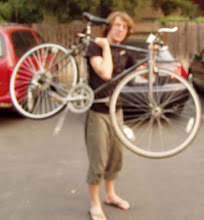We made two one-gallon batches of my California Sunshine Ale. The first was a simple scale-down of the recipe I posted earlier. The second was a variant that completely dropped Cascade hops for Amarillo.
 It's pretty uncommon to brew in one-gallon batches. Practically every recipe online is written for five gallons. Brewing at all is a lot of work, so people try and make it worth their while. Larger batches are also more stable and, according to the owner of our local brew store, a difference of scale changes extraction rates and thereby the recipe requirements.
It's pretty uncommon to brew in one-gallon batches. Practically every recipe online is written for five gallons. Brewing at all is a lot of work, so people try and make it worth their while. Larger batches are also more stable and, according to the owner of our local brew store, a difference of scale changes extraction rates and thereby the recipe requirements.I decided to brew in small batches knowing full well the reasons it was uncommon. I didn't get into homebrewing to save money. The ingredients for making beer cost roughly half the retail price for buying craft beer from the store. That may sound pretty good, but when I take into account the work and risk involved in the process and the superior quality and variety of beer available at the store, it's barely breaking even. Five gallons makes fifty beers and that is a heck of a lot of any single kind of beer for a person who's accustomed to buying single bottles. The fuzzy feeling that comes from knowing my beer was made with my own hands only gets me so far. I decided to start homebrewing to learn more about beer and to kick around my own recipe ideas. We may have had to borrow Howard's lab scale to measure hops in hundreths of an ounce, but I'm a scientist, after all.

So after one and a half hours of driving and one and a half days' work, Howard and I have twenty-three bottles of beer to show for it and that's fine by me.
 Above: Our cooling system to keep the beer around 70 degrees in the middle of the Davis summer (my idea)
Above: Our cooling system to keep the beer around 70 degrees in the middle of the Davis summer (my idea)Below: Our chicken wire drying rack (Howard's idea)
 On a separate note, it has come to my attention that American brewers have been time traveling from years past into our present future and viciously stealing my beer ideas from this blog. It turns out that Cascadian Dark Ale aka Black IPA is an established northwestern variant on the IPA style that uses dark malts to conjure an intimidating color. While it sounds like a lot of breweries are using debittered black malt to give the maximum color without affecting flavor that much, some have actually embraced the pairing of hop bitterness and roasted maltiness.
On a separate note, it has come to my attention that American brewers have been time traveling from years past into our present future and viciously stealing my beer ideas from this blog. It turns out that Cascadian Dark Ale aka Black IPA is an established northwestern variant on the IPA style that uses dark malts to conjure an intimidating color. While it sounds like a lot of breweries are using debittered black malt to give the maximum color without affecting flavor that much, some have actually embraced the pairing of hop bitterness and roasted maltiness.Also, on the day before we bottled our California Sunshine Ale, I happened across the spitting image of my concept for the beer. Deschutes Brewery's Twilight Summer Ale is an APA that lightens up on the crystal malt, adds something toasty to pair with grilled food and relies on a combination of four hops with emphasis on Amarillo.
To counterbalance said losses from my creative stable, I'd like to present a new beer concept. I was idly reading the ingredient list on Barq's Root Beer and noticed that the last ingredient was acacia. For those of you who don't know, acacia is planted as a shrub all over orange county hillsides for erosion control. It has oval grey leaves and little fuzzy yellow flowers that get pollen all over the place. It has a very distinctive smell, like a dirty, grainy version of some platonic true herb. As soon as I'd read it I started to either imagine or taste it in the Barq's (to my satisfaction).
Acacia would be great in a light summer porter. You heard it from me first, somebody should brew a summer porter with acacia leaves.

No comments:
Post a Comment